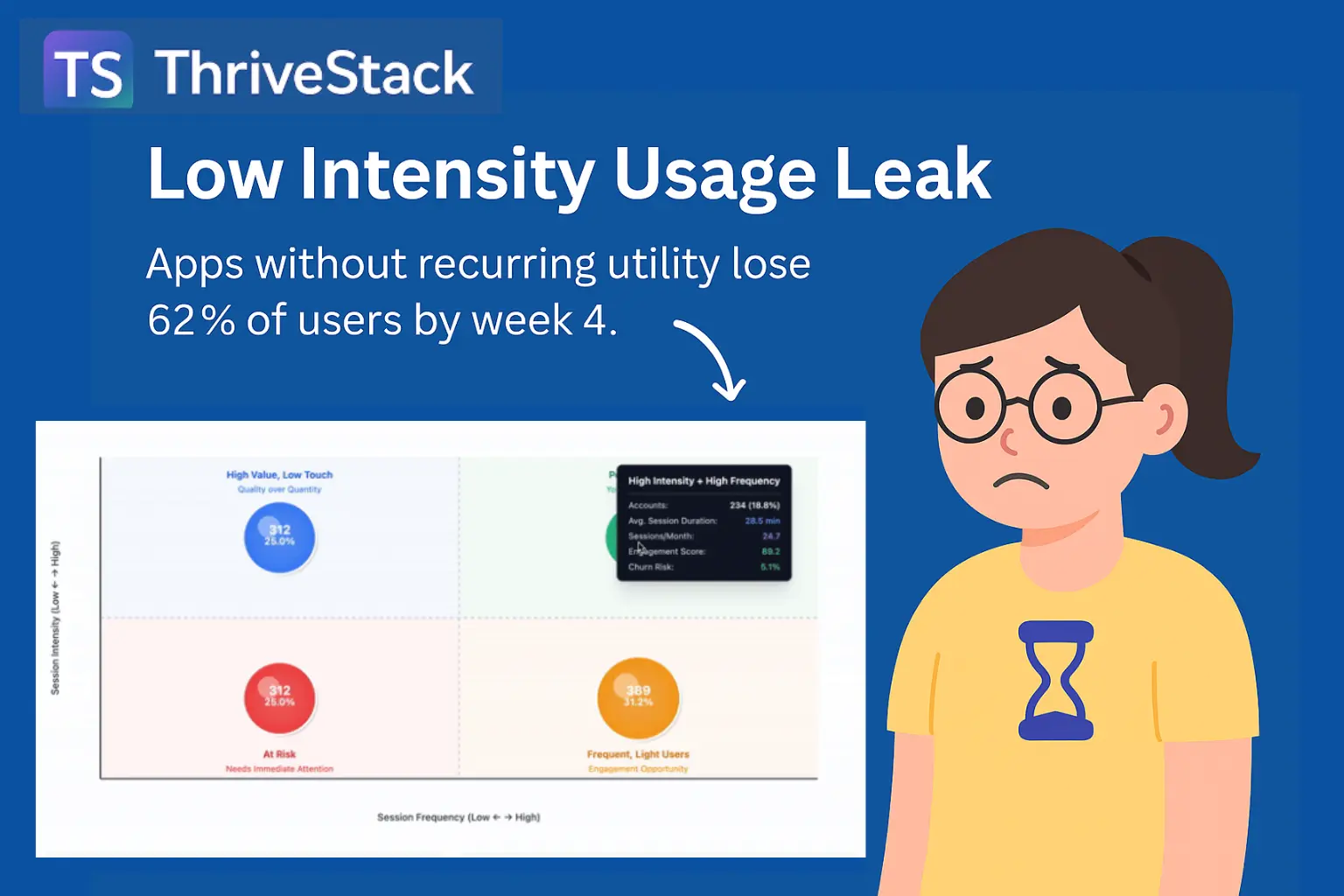Your product is open, but the engine’s idling, not racing.
When users just “dabble,” your growth flattens—and your churn risk quietly explodes.
Leak Description: Low Intensity Usage Leak
This is the silent growth leak that happens when users log in, but barely scratch the surface. Their sessions are infrequent, short, or only touch basic features. You see DAUs and logins in your dashboard, but value isn’t compounding—usage is shallow. Welcome to the "Low Intensity Usage Leak." These are the users who are active in name only—and at highest risk for churn, downgrade, and low NPS.
Example: A B2B collaboration tool where most users only read notifications and never create or comment on documents—missing the deeper value.
Why You Should Care About the Low Intensity Usage Leak
- 40% of SaaS churn comes from low-engaged users who “show up” but never form deep habits (Totango Benchmarks).
- Low-intensity users are 3x more likely to churn than highly engaged users.
- Most SaaS products see <15% of users using high-value features weekly.
“The true enemy isn’t inactivity. It's the shallow engagement that goes unnoticed until it’s too late.”
— John Cutler, Product Evangelist
Why the Low Intensity Usage Leak Happens
- Onboarding only covers basics, not advanced/high-value features
- No habit formation loops—users never progress from beginner to power user
- Feature complexity, unclear next steps, or overwhelming UI
- Lack of personalized value prompts or success milestones
The Psychology Behind It:
- Fogg Behavior Model: Without clear motivation and ability triggers, users plateau at low engagement
- Progress Principle (Amabile & Kramer): People crave visible progress—if they don’t see it, motivation drops
How to Detect the Low Intensity Usage Leak
Step-by-Step Diagnostic:
- Segment users by feature depth and session frequency
- Track feature adoption velocity (how many features used over time)
- Analyze session duration and frequency against product value milestones
- Correlate NPS and CSAT with intensity of product usage
How ThriveStack Can Help with Low Intensity Usage Leak
Please review the content. This is auto-generated and may not match the product features
Note: Prateek, please add product walkthroughs for this section
Features
- Feature Adoption Heatmaps
- Session Intensity Distribution

Track accounts based on Session counts and Average session durations

Detection Steps
- Use ThriveStack’s Feature Depth dashboard to identify “dabbling” cohorts
- Track Feature Depth Index trends and correlate with churn risk
- Set up usage intensity segments to trigger targeted interventions
Fix Actions
- Launch nudges & guided tours for under-used advanced features
- Automate milestone celebrations as users deepen engagement
- Personalize progress journeys and success plans
Prevention Strategies
- Build personalized onboarding tracks for power user features
- Set up habit loops: in-app rewards, tips, and achievement triggers
- Continually measure and iterate on usage intensity segments
Customer Psychology: Why This Fix Works
“People are motivated by progress, mastery, and visible achievement. When SaaS products reward and guide deep engagement, usage intensity—and loyalty—skyrocket.” — Katy Milkman, Behavioral Scientist
Aligning triggers, visible milestones, and social proof with product usage encourages users to move beyond basics. This reduces shallow engagement and builds lasting value.
Business Impact of Fixing the Low Intensity Usage Leak
- 20-30% increase in power user cohort size after nudging deeper feature adoption (Pendo research).
- Companies report 50% higher retention among users who engage with 3+ core features weekly.
- “Intense engagement compounds growth—shallow usage compounds churn.” — Hiten Shah, SaaS Growth Leader
Growth Expert Quotes
“If you want durable growth, obsess over the journey from activation to power user. That’s where real value lives.” — Lenny Rachitsky, Growth Advisor
“Low-intensity usage is the red flag most teams ignore until churn explodes. Track it. Fix it.” — Brian Balfour, Reforge
Ready to Fix the Low Intensity Usage Leak?
Use ThriveStack to surface your hidden dabblers, automate journeys toward deep engagement, and grow your power user cohort. Or talk to a ThriveStack expert to craft your usage intensity strategy today.
Conclusion: Turn Dabblers Into Power Users(h2)
Low-intensity usage isn’t just a silent leak—it’s a growth killer hiding in plain sight. Users may log in, but if they’re not engaging deeply, your product’s true value stays locked. To unlock sustainable growth, SaaS teams must actively convert surface-level users into power users.
ThriveStack helps you do exactly that—with actionable insights, automated nudges, and engagement playbooks designed to deepen product adoption and prevent silent churn.
Start building power users today. Book a Demo with ThriveStack.
See how you can diagnose and fix low-intensity usage leaks to drive lasting SaaS growth.
Frequently Asked Questions (FAQ)
1. What is the Low Intensity Usage Leak?
It’s when users log in but barely engage with your product’s core features. They remain stuck in shallow usage patterns, increasing churn risk over time.
2. How is this different from inactive users?
Inactive users leave. Low-intensity users stay but don’t extract value—creating misleading retention numbers and hidden churn risk.
3. Why do SaaS companies struggle to detect this leak?
Most dashboards track logins and DAUs, but few measure feature depth or session quality. This makes it easy to miss the warning signs.
4. How does ThriveStack help?
ThriveStack tracks usage intensity, highlights shallow engagement patterns, and triggers interventions like nudges, tours, and personalized success milestones to drive deeper feature adoption.
5. What’s the business impact of fixing this leak?
Companies see a 20–30% increase in power users and up to 50% better retention when they successfully guide users into richer product engagement.

